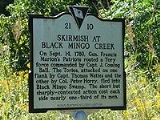
Battle of Black Mingo
Encyclopedia
The Battle of Black Mingo was a skirmish during the American Revolution
. It took place in September of 1780 in the vicinity of Dollard's Tavern near Black Mingo Creek
not far from Willtown, South Carolina. General Francis Marion
attacked and scattered a contingent of Loyalist
troops that had been left to secure the region by Colonel Banastre Tarleton
after his destructive march through the area. The Loyalists, under Colonel John Coming Ball, were driven into the nearby swamp after suffering significant casualties.
in the wake of the Battle of Ramsour's Mill
. Marion then engaged in a series of guerrilla actions to harry elements of the British force and its Loyalist
supporters. Following their victory at Camden
the British sent out contingents to secure the countryside and capture prominent Patriot leaders like Marion. These activities reduced company morale, and the hunt for Marion caused men to leave his company, until he only had about 60 left and was forced to retreat into hiding in the swamps of the border between North and South Carolina.
The British then traveled across South Carolina, plundering and destroying Patriot properties. This prompted Marion to move into South Carolina, where Patriots angered by the British action signed up in large numbers. He was alerted to the presence of a large number of Loyalists near Black Mingo Creek
, then 15 miles (24.1 km) away. While the reports indicated that the Loyalist numbers were larger than his own, the enthusiasm of his men prompted him to agree to an attack.
American Revolution
The American Revolution was the political upheaval during the last half of the 18th century in which thirteen colonies in North America joined together to break free from the British Empire, combining to become the United States of America...
. It took place in September of 1780 in the vicinity of Dollard's Tavern near Black Mingo Creek
Black Mingo Creek
Black Mingo Creek is a tributary to the Black River in coastal South Carolina. It derives its name from mingo or minko, the Chickasaw word for chief. This area was a special hunting ground and a center of the eastern Chickasaw in colonial times....
not far from Willtown, South Carolina. General Francis Marion
Francis Marion
Francis Marion was a military officer who served in the American Revolutionary War. Acting with Continental Army and South Carolina militia commissions, he was a persistent adversary of the British in their occupation of South Carolina in 1780 and 1781, even after the Continental Army was driven...
attacked and scattered a contingent of Loyalist
Loyalist (American Revolution)
Loyalists were American colonists who remained loyal to the Kingdom of Great Britain during the American Revolutionary War. At the time they were often called Tories, Royalists, or King's Men. They were opposed by the Patriots, those who supported the revolution...
troops that had been left to secure the region by Colonel Banastre Tarleton
Banastre Tarleton
General Sir Banastre Tarleton, 1st Baronet, GCB was a British soldier and politician.He is today probably best remembered for his military service during the American War of Independence. He became the focal point of a propaganda campaign claiming that he had fired upon surrendering Continental...
after his destructive march through the area. The Loyalists, under Colonel John Coming Ball, were driven into the nearby swamp after suffering significant casualties.
Background
A company of militia was placed under the command of Brigadier General Francis MarionFrancis Marion
Francis Marion was a military officer who served in the American Revolutionary War. Acting with Continental Army and South Carolina militia commissions, he was a persistent adversary of the British in their occupation of South Carolina in 1780 and 1781, even after the Continental Army was driven...
in the wake of the Battle of Ramsour's Mill
Battle of Ramsour's Mill
The Battle of Ramsour's Mill took place on June 20, 1780 near present-day Lincolnton, North Carolina, during the British campaign to gain control of the southern colonies in the American Revolutionary War. About 400 American militia defeated 1,300 Loyalist militiamen. The battle did not involve any...
. Marion then engaged in a series of guerrilla actions to harry elements of the British force and its Loyalist
Loyalist (American Revolution)
Loyalists were American colonists who remained loyal to the Kingdom of Great Britain during the American Revolutionary War. At the time they were often called Tories, Royalists, or King's Men. They were opposed by the Patriots, those who supported the revolution...
supporters. Following their victory at Camden
Battle of Camden
The Battle of Camden was a major victory for the British in the Southern theater of the American Revolutionary War...
the British sent out contingents to secure the countryside and capture prominent Patriot leaders like Marion. These activities reduced company morale, and the hunt for Marion caused men to leave his company, until he only had about 60 left and was forced to retreat into hiding in the swamps of the border between North and South Carolina.
The British then traveled across South Carolina, plundering and destroying Patriot properties. This prompted Marion to move into South Carolina, where Patriots angered by the British action signed up in large numbers. He was alerted to the presence of a large number of Loyalists near Black Mingo Creek
Black Mingo Creek
Black Mingo Creek is a tributary to the Black River in coastal South Carolina. It derives its name from mingo or minko, the Chickasaw word for chief. This area was a special hunting ground and a center of the eastern Chickasaw in colonial times....
, then 15 miles (24.1 km) away. While the reports indicated that the Loyalist numbers were larger than his own, the enthusiasm of his men prompted him to agree to an attack.

